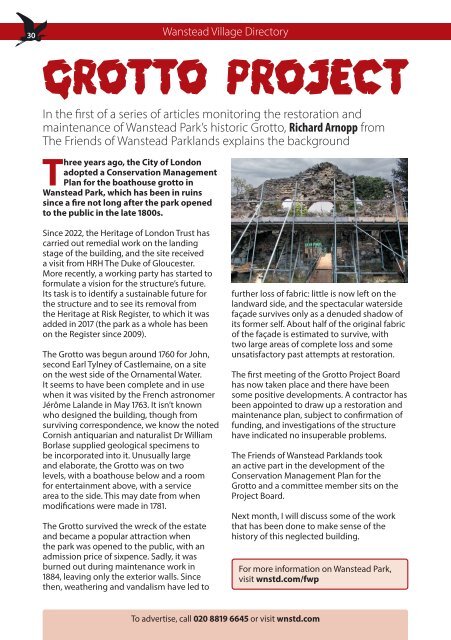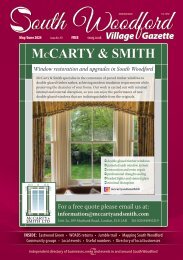December 2023
You also want an ePaper? Increase the reach of your titles
YUMPU automatically turns print PDFs into web optimized ePapers that Google loves.
30<br />
Wanstead Village Directory<br />
GROTTO PROJECT<br />
In the first of a series of articles monitoring the restoration and<br />
maintenance of Wanstead Park’s historic Grotto, Richard Arnopp from<br />
The Friends of Wanstead Parklands explains the background<br />
Three years ago, the City of London<br />
adopted a Conservation Management<br />
Plan for the boathouse grotto in<br />
Wanstead Park, which has been in ruins<br />
since a fire not long after the park opened<br />
to the public in the late 1800s.<br />
Since 2022, the Heritage of London Trust has<br />
carried out remedial work on the landing<br />
stage of the building, and the site received<br />
a visit from HRH The Duke of Gloucester.<br />
More recently, a working party has started to<br />
formulate a vision for the structure’s future.<br />
Its task is to identify a sustainable future for<br />
the structure and to see its removal from<br />
the Heritage at Risk Register, to which it was<br />
added in 2017 (the park as a whole has been<br />
on the Register since 2009).<br />
The Grotto was begun around 1760 for John,<br />
second Earl Tylney of Castlemaine, on a site<br />
on the west side of the Ornamental Water.<br />
It seems to have been complete and in use<br />
when it was visited by the French astronomer<br />
Jérôme Lalande in May 1763. It isn’t known<br />
who designed the building, though from<br />
surviving correspondence, we know the noted<br />
Cornish antiquarian and naturalist Dr William<br />
Borlase supplied geological specimens to<br />
be incorporated into it. Unusually large<br />
and elaborate, the Grotto was on two<br />
levels, with a boathouse below and a room<br />
for entertainment above, with a service<br />
area to the side. This may date from when<br />
modifications were made in 1781.<br />
The Grotto survived the wreck of the estate<br />
and became a popular attraction when<br />
the park was opened to the public, with an<br />
admission price of sixpence. Sadly, it was<br />
burned out during maintenance work in<br />
1884, leaving only the exterior walls. Since<br />
then, weathering and vandalism have led to<br />
further loss of fabric: little is now left on the<br />
landward side, and the spectacular waterside<br />
façade survives only as a denuded shadow of<br />
its former self. About half of the original fabric<br />
of the façade is estimated to survive, with<br />
two large areas of complete loss and some<br />
unsatisfactory past attempts at restoration.<br />
The first meeting of the Grotto Project Board<br />
has now taken place and there have been<br />
some positive developments. A contractor has<br />
been appointed to draw up a restoration and<br />
maintenance plan, subject to confirmation of<br />
funding, and investigations of the structure<br />
have indicated no insuperable problems.<br />
The Friends of Wanstead Parklands took<br />
an active part in the development of the<br />
Conservation Management Plan for the<br />
Grotto and a committee member sits on the<br />
Project Board.<br />
Next month, I will discuss some of the work<br />
that has been done to make sense of the<br />
history of this neglected building.<br />
For more information on Wanstead Park,<br />
visit wnstd.com/fwp<br />
To advertise, call 020 8819 6645 or visit wnstd.com
















